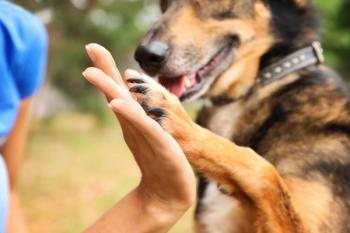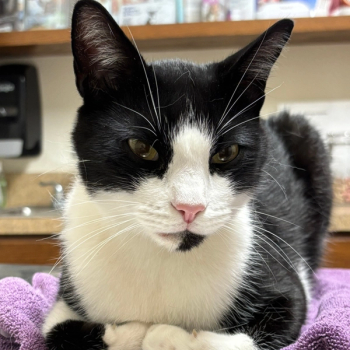
- Hospital Design360 June 2021
- Volume 2
- Issue 1
How to plan for the"pee line”
Running a clean clinic is the dream, but it can be hard to maintain in a pet-friendly space. Here are a few design strategies to help keep the workplace glistening.
As an industry professional, you do your best to keep your clinic sparkling clean. However, there is 1 particular situation that poses a unique challenge—the notorious leg lifters! Everybody knows that accidents happen, but whether the patient is large or small, urine of any kind is still extremely damaging to certain materials. Over the course of this article, we will share knowledge about why urine interacts so negatively with your floors, walls, and other areas. We will also provide tips, tricks, and methods for protecting your clinic from the damages of pet urine. Because let’s face it, when they’ve got to go, they’ve got to go!
Urine hazards
Dog urine poses a significant threat because of its chemical makeup. Although all urine is primarily water (with inorganic salts and nitrogen-rich by-products such as uric acid and creatine), dog urine is much more concentrated. Did you know urine can even etch stone? The chemicals present in your pet’s urine are much more destructive.
To make things worse, urine can soak through wall and floor materials and get trapped out of reach of your cleaning efforts. Through absorption, it will penetrate the core of porous surfaces, and that is where the real problem begins.
As urine breaks down and dries, it becomes more challenging to see, let alone clean. As the remaining water evaporates, a high concentration of ammonia is left behind, and a sulfur-containing chemical is formed, producing unpleasant smells. This high concentration of ammonia is a key reason to never use cleaning products also containing ammonia on affected areas. The scent will be familiar and lead your pet to believe that it is a “safe” place for them to leave their mark. Additionally, the uric acid in dog urine has a crystal-like structure that does not dissolve well in water. The crystals that remain after the liquid dries are why cleaning with soap and water alone will not resolve the issue. Traces of urine will be left behind.
Issues like these have led our architect design team to develop a useful design guideline we call the “pee line,” which is an imaginary line we use to indicate the worst-case scenario height for these leg lifters. It takes into consideration where urine can reach for any size of dogs, from Chihuahua to Great Dane. In our experience, the pee line occurs over 1 m above the floor, and all finishes below it need to be selected, installed, and maintained to be durable and washable enough to withstand damage from urine.
Cleaning supplies
If a furry friend does decide to urinate at an inopportune time and place, there are some products we recommend using for cleanup. A water-based grout residue remover is ideal for keeping tile floors and natural stone looking stain-free and polished. It gets into those hard-to-reach crevices where urine is likely to get trapped and keeps them looking haze-free. These products are ideal for both epoxy and cement-based grouts and will keep the tile itself looking shiny and clean.
Another option is a heavy-duty alkaline floor cleaner that eliminates tough stains and protein-based build-ups, especially on textured surfaces such as epoxy floors. These products are safe to use and go above and beyond to prevent stains from ruining your finishes.
Design solution
Now that we have covered the cleanup process, we will discuss some material options proven to be reliable and able to withstand urine and liquid stains of all kinds.
As discussed above, one of the most common problem areas for pet stains is the floor. We recommend using a more durable material, such as epoxy, porcelain tile, or sheet vinyl, especially in high-traffic areas. In addition to choosing the correct materials, it is just as important to seal and install the products correctly. This will lower the absorption rate and make floors more resistant to urine and other fluids, including cleaning supplies.
Keep in mind that the pee line concept extends above the floor, so it is also crucial to consider what is applied on cabinetry and other vertical surfaces. Plastic laminates are a good example of a cleanable material that most hospitals use for exam room cabinetry. When laminates are properly cleaned and protected, uric acid crystals will not be left behind to erode the material and peel away the edges and corners of surfaces. In high traffic or wet areas, metal or hard plastic corner guards can be placed on the edges to shield and better hold the material in place, keeping your area looking new over a longer time period.
There are some materials to avoid using altogether. Porous surfaces like carpet can absorb and trap fluids within the fibers and allow them to spread underneath, producing unwanted odors. Liquids move from wet to dry regions and, perhaps surprisingly, surfaces as seemingly hard as concrete and brick contain pores that confine excess liquids. When these porous materials get wet on one end, the pores begin filling with that liquid and spread throughout. Our recommendation is to stick with nonporous materials, like porcelain tile, solid surface products, or plastic laminate wherever possible.
The takeaway
The world of veterinary design is changing and progressing every day. We hope we can offer insights to help empower you to make the most informed decision for your practice. With an understanding of available materials and how they will perform, it will be easier to keep your clinic looking, lasting, and smelling brand-new for years to come!
Started in 2000 by Rick Renschen, MD Architects has presence from coast to coast with a national portfolio of animal care, human care, and commercial projects. The company is actively registered in 35 states and has a running list of upwards of 180 animal care projects across the country.
Articles in this issue
over 4 years ago
Design without barriersover 4 years ago
COVID-19 keepers: Practice design changes that should stayover 4 years ago
Designing for emergency casesNewsletter
From exam room tips to practice management insights, get trusted veterinary news delivered straight to your inbox—subscribe to dvm360.





